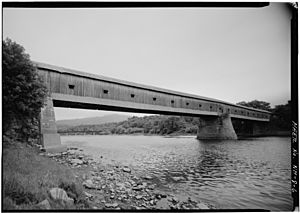Cornish–Windsor Covered Bridge facts for kids
Quick facts for kids Cornish–Windsor Covered Bridge |
|
|---|---|
 |
|
| Crosses | Connecticut River |
| Locale | Cornish, New Hampshire to Windsor, Vermont |
| Maintained by | New Hampshire Department of Transportation |
| Characteristics | |
| Design | Town lattice truss bridge |
| Material | wood |
| Total length | 449 feet 5 inches (136.98 m) |
| Width | 24 feet (7.3 m) |
| Longest span | 204 feet (62 m) |
| Load limit | 10 short tons (9.1 t) |
| Clearance below | 12 feet 9 inches (3.89 m) |
| History | |
| Construction end | 1866 |
|
Cornish–Windsor Covered Bridge
|
|
| Lua error in Module:Location_map at line 420: attempt to index field 'wikibase' (a nil value). | |
| Nearest city | Windsor, VT |
| Built | 1866 |
| NRHP reference No. | 76000135 |
| Added to NRHP | November 21, 1976 |
The Cornish–Windsor Covered Bridge is a very old covered bridge. It connects two states: Cornish, New Hampshire and Windsor, Vermont. The bridge crosses the Connecticut River. It was built in 1866 and is made of wood. For a long time, it was the longest covered bridge in the United States. It's a special type of bridge called a lattice truss bridge.
Contents
Bridge History
Older Bridges on This Spot
Before the current bridge, three other bridges stood here. They were built in 1796, 1824, and 1828. Businessmen like Allen Wardner helped build and run the bridges from 1824 and 1828.
The Current 1866 Bridge
The bridge you see today was built in 1866. It was constructed by Bela Jenks Fletcher and James Frederick Tasker. The cost to build it was about $9,000. This would be like paying over $200,000 today!
The bridge is about 449 feet (137 meters) long. It is also about 24 feet (7 meters) wide. The design uses a special "lattice" pattern. This pattern was invented by Ithiel Town.
Tolls and "Kissin' Bridge"
From 1866 until 1943, people had to pay a toll to cross the bridge. In 1866, it cost 2 cents for people walking into New Hampshire. But it cost 3 cents to walk back into Vermont. A carriage with four horses cost 20 cents.
Covered bridges were sometimes called "kissin' bridges." This was because they offered a brief moment of privacy. People could share a quick kiss while crossing.
New Hampshire bought the bridge in 1936. It became free to cross in 1943.
Special Recognition and Repairs
The Cornish–Windsor Covered Bridge has received important honors:
- 1970: The American Society of Civil Engineers named it a National Civil Engineering Landmark. This means it's a very important engineering achievement.
- 1976: The bridge was added to the National Register of Historic Places. This list includes places important to American history.
- 1988: The bridge was repaired and made stronger. The money for this came from the government.
Longest Bridge Status
For many years, the Cornish–Windsor Covered Bridge was known as the longest covered bridge in the United States.
It is still the longest wooden covered bridge that cars can drive on. Other bridges might be longer overall. Some have longer single sections. But they might be for walking only, or made of different materials. For example, the Smolen–Gulf Bridge in Ohio is longer overall. But the Cornish–Windsor Bridge is special because it's a long wooden covered bridge for cars.
How to Visit the Bridge
The bridge is easy to find from both Vermont and New Hampshire.
From Vermont
If you are in Windsor, Vermont, find Vermont Route 44. Follow it southeast until it meets Main Street. Keep going straight past Main Street. The road will become Bridge Street. Drive about two-tenths of a mile (350 meters) on Bridge Street. You will reach the bridge.
When you enter the bridge from Vermont, you are immediately in New Hampshire. This is because the state line is on the Vermont side of the river.
From New Hampshire
If you are in Cornish, New Hampshire, look for New Hampshire Route 12A. This road is also called Town House Road. If you are coming from the south, Bridge Road will be a left turn. If you are coming from the north, from West Lebanon, New Hampshire, Route 12A is a very pretty drive along the Connecticut River.
Historical Marker
Near the bridge on the Cornish side, there is a parking area. It's a great spot to view the bridge. Here, you will also find a New Hampshire historical marker. This sign tells more about the bridge's history. It is one of four historical markers in Cornish.


